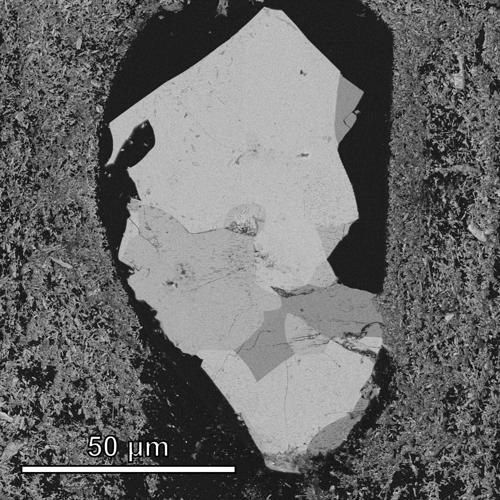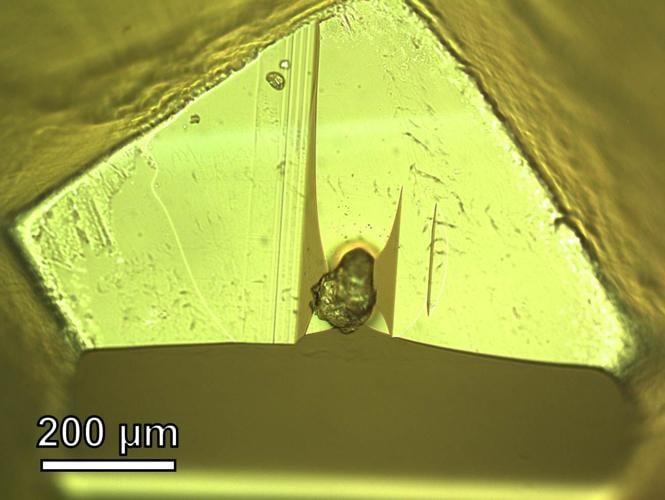A salty discovery by scientists at the University of Arizona suggests water might be more common than previously thought on many asteroids in the solar system.
Researchers identified microscopic salt crystals that could only have formed in the presence of liquid water while sifting through the dust from a common class of asteroids thought to be largely dry.

The asteroid Itokawa, as photographed by the Japanese spacecraft Hayabusa during its close approach in 2005. Samples collected by Hayabusa are central to a new study by researchers at the University of Arizona.
The find could bolster the idea that most, if not all, of the water on Earth was delivered here long ago inside space rocks.
The analysis by Tom Zega and Shaofan Che from the UA’s Lunar and Planetary Laboratory involved a single particle of dust, roughly twice the diameter of a human hair, that was collected from the near-Earth asteroid Itokawa in 2005 by Japan’s Hayabusa spacecraft.
Their study, published June 12 in Nature Astronomy, is the first to prove that the sodium chloride crystals formed when the asteroid was in space and are not the result of contamination after the sample was brought to Earth in 2010.
"The grains look exactly like what you would see if you took table salt at home and placed it under an electron microscope," said Zega, a professor of planetary sciences at the UA, in a written statement.

An artist rendering shows the Hayabusa spacecraft collecting a sample from the asteroid Itokawa. The Japan Aerospace Exploration Agency mission was the first to bring material from an asteroid back to Earth.
To determine if the salt came from human sweat or some other terrestrial source, researchers cut a tiny section — smaller than a red blood cell — from the dust particle and subjected it to a number of techniques.
"We ruled out every possible source of contamination," Che said.

An electron microscope image of an asteroid dust particle, in which University of Arizona researchers confirmed the presence of salt crystals formed by water in space.
The finding is significant, Zega said, because Itokawa is a type of asteroid that makes up about 87% of the meteorites collected on Earth but are rarely found to contain water-bearing minerals.
"Our discovery of sodium chloride tells us this asteroid population could harbor much more water than we thought," he said.
Most scientists believe Earth and the other rocky inner planets formed about 4.5 billion years ago within a swirling cloud of gas that surrounded the young sun and was too hot to allow water vapor to condense.
"In other words, the water here on Earth had to be delivered (later) from the outer reaches of the solar nebula, where temperatures were much colder and allowed water to exist, most likely in the form of ice," Che said.
Research led in the 1990s by the late Michael Drake, former director of the UA’s Lunar and Planetary Lab, showed how water molecules in the early solar system could have been trapped in asteroid minerals and survived an impact on Earth.
"Those studies suggest several oceans worth of water could be delivered just by this mechanism," Zega said.
Icy comets or asteroids from more distant reaches of the solar system are thought to be the most likely source, but the salt found hiding inside Itokawa hints at another, much closer cosmic watering hole.
"If it now turns out that the most common asteroids may be much 'wetter' than we thought,” Zega said, “that will make the water delivery hypothesis by asteroids even more plausible."

A dust particle from asteroid Itokawa is coated in epoxy resin in the lab to prepare it for thin sectioning. The particle is roughly the width of a human hair.
The Japan Aerospace Exploration Agency followed up its Hayabusa mission with Hayabusa2, which launched in 2014, collected samples from the asteroid Ryugu and returned them to Earth in 2020.
NASA’s asteroid-sampling spacecraft, OSIRIS-REx, is now on its way home with its payload of rocks after a UA-led mission to Bennu.
That several-billion-mile trip is slated to end on Sept. 24, when a sample-return capsule from OSIRIS-REx is set to land at the Utah Test and Training Range, west of Salt Lake City.







